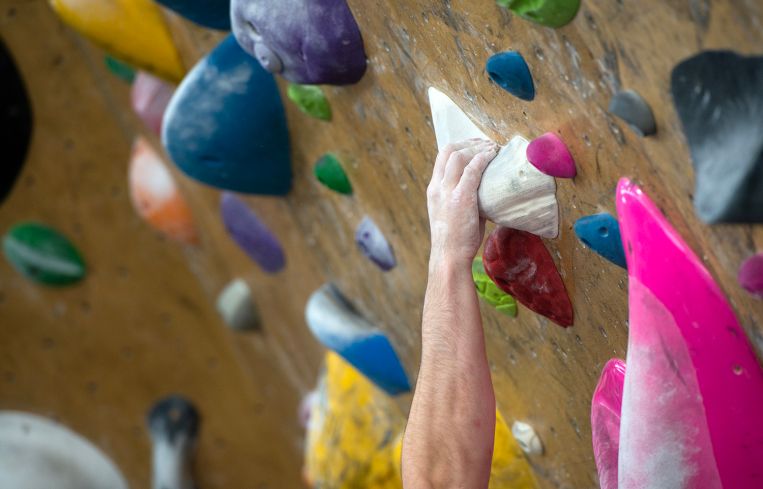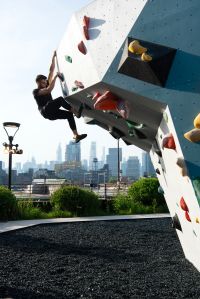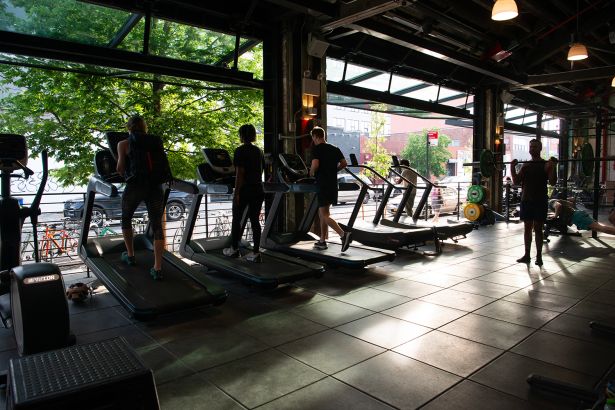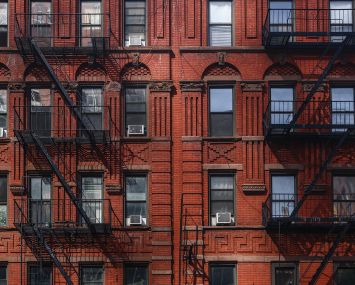Climbing Gyms Scale in New York City
A growing number of indoor climbing gyms have taken over retail spaces in New York and across the country
By Nicholas Rizzi June 11, 2024 6:00 am
reprints
On a recent Tuesday afternoon, several people hung upside down in a Bushwick, Brooklyn, warehouse. This wasn’t a rehearsal for a revival of the doomed Spiderman play, but people pulling on plastic crimps and pinches as they attempted to scale a wall in the recently reopened GP81 climbing gym at 79 Jefferson Street.
And GP81 isn’t alone. It’s one of an increasing number of indoor climbing and bouldering gyms that have cropped up around New York City in recent years, with three opening or slated to open just this year, drawing hundreds of climbers to their walls each day.
“There’s been a huge growth since 2019,” said Julian Acevedo, who co-founded GP81 seven years ago in Greenpoint, Brooklyn, with Clifford Simanski. “There’s been a bubble growing.”
So far this year, GP81 reopened in a new Bushwick space in May, just a few blocks from another gym, MetroRock Bushwick. The Bouldering Project also debuted at 575 Degraw Street in Brooklyn’s Gowanus in January, while Vital Climbing Gym is gearing up to open its fourth New York City outpost inside the Lower East Side’s Essex Crossing in September.

“What people have been searching for is a way to stay fit that’s not going to a 24 Hour Fitness, just lifting weights mindlessly,” said Nam Phan, a co-founder of Vital. “I think climbing is a great outlet for that because it’s so social.”
The city currently boasts a dozen dedicated climbing gyms spread throughout Manhattan, Queens and Brooklyn. They offer a mix of bouldering — a just-off-the-floor activity that requires no equipment other than a pair of climbing shoes and chalk — and rope-assisted climbing that allows climbers to scale indoor walls up to 55 feet high.
That’s a far cry from 15 years ago, when the city’s first climbing gym, Brooklyn Boulders, opened at 575 Degraw in 2009. (Brooklyn Boulders later shut down that space but still has a location in Long Island City, Queens, as well as others outside the city.) But it’s not just New York City seeing a huge boom in these gyms.
From its humble beginnings in the 1980s with rocks glued to cinder-block walls in warehouses, climbing gyms have become big business. The number of these spaces nationally grew by 76 percent in less than a decade, from 353 sites in 2014 to 622 in 2023, and there’s now 819 in North America, most of those in the U.S., according to Climbing Business Journal. The industry is also expected to grow in value by $4.18 billion from 2022 to 2027, according to research firm Technavio.
“If you look at any industry, they usually follow a typical kind of path, and I think we’re in that explosive path,” said Charlotte Bosley, the chief marketing officer for the country’s largest climbing gym chain, Movement. “We’re right now in the place where a lot of climbing gyms are open and we have some major players that are starting to acquire and create that national footprint.”
Part of the reason the industry clamped on to this path is climbing has become “more accessible,” Bosley said. It was introduced in the summer Olympics four years ago, more walls can be found in YMCAs and other facilities, plus documentaries like “Free Solo,” which chronicled Alex Honnold’s unroped ascent of a 3,000-foot wall in Yosemite National Park, helped bring the sport into the public eye.
And there’s also been the increasing popularity of outdoor bouldering, in which climbers have to scale only about 15 feet or so and don’t need a harness or other safety gear, meaning less training and costs to get started, Simanski said.
“You don’t need lessons, you don’t have to have equipment,” Simanski said. “You can just buy a crash pad [a soft mat in case you fall] or not, and just climb.”

Bouldering’s popularity has been a boon for gyms as well since it requires a lot less space than rope-assisted climbing. Gyms like GP81 and Vital have eschewed rope climbing altogether to solely focus on bouldering.
The increase in city-based climbing gyms has also helped fuel a rise in the number of people interested in the sport, since it’s a lot easier to take a subway to Williamsburg, Brooklyn, than get upstate to the Adirondacks or the Shawangunk Mountains.
“It’s hard to access because it’s out in the wilderness,” said Vital co-founder David Sacher. “Now gyms have brought the sport into the city a little bit so people who might have had a difficult time getting out to learn to climb in Yosemite can now learn to climb in the city, and then take weekend trips or summer trips outside.”
The expansion of climbing gyms coincided with a post-pandemic boom in the fitness industry, with monthly memberships and the number of new gyms growing in 2022, and climbing gyms have changed with the broader fitness industry. Gone are the days of small warehouses with wooden holds — one of the most famous being the “School Room” that took over a 30-by-30-foot classroom in Sheffield, England, in the 1990s — and many now resemble an Equinox with plenty of exercise bikes and other equipment for non-
climbing workouts.
“Fourteen years ago when we started, rock climbing gyms were small, dark, dusty, cheap, old warehouses beside the freeway,” Vital’s Nam said. “Now climbing gyms have become these full-service fitness facilities where in addition to climbing you have fitness, weightlifting, yoga classes and cycling classes. That’s what we are trying to do.”
Vital went one step further by having coworking space built into its Williamsburg location. It’s not uncommon to see people jump on a Zoom work call and then try to tackle a V4 boulder.

Movement has also been leaning into these kinds of facilities and, when added to the climbing, they make membership a better value for customers than other gyms, Bosley said. “All of a sudden you’re getting all of these different fitness activities within this one price,” she said. “I just think [that has] really helped to fuel the growth of the sport.”
Movement charges $115 a month for its membership while Vital charges $145 per month. Cost-of-living website Numbeo found that gym memberships in New York City averaged $106 a month in 2022.
While many climbing gyms have tried to ride the boutique fitness trend to get more people through their doors, GP81 went in the opposite direction. The gym adopted the catchphrase “Anti-Mega,” meaning mega-gyms, that it plastered on T-shirts and stickers, and even uses it for its email address.
“We just don’t want to be another mega-gym,” Simanski said. “It just kind of clicked, and we really latched onto the idea that we were going to be an independent operator and the DIY-style of homegrown.”
To that end, GP81 doesn’t offer birthday parties or lessons for beginners, and there’s only basic workout equipment, mainly to aid in training to make people better climbers.
“It kept pushing us further and further away from where commercial climbing gyms were going, and we’re really entrenched in this,” Acevedo said.
Regardless of a visitor’s stance on multifaceted gyms, getting any of them open isn’t an easy climb. Even bouldering-only gyms need at least 20-foot ceilings and column-free spaces to be able to squeeze in as many walls as possible. That puts them in direct competition with plenty of other retailers looking for the exact same spaces, including industrial tenants, pickleball courts and traditional gyms.
“The only reason we now have one and we’re opening our second in seven years is because of the difficulty in finding space,” said CBRE’s Lon Rubackin, who brokered the deals for Vital’s Williamsburg and Lower East Side locations. “Those spaces are few and far between, and almost nonexistent in Manhattan.”
When Vital decided it wanted to shift from the West Coast to the East Coast, it targeted Williamsburg and the Lower East Side as the best two options. But because of its space requirements — it aims to open locations between 40,000 to 60,000 square feet — it couldn’t move quickly.
Rubackin knew the recently developed Essex Crossing could work and targeted it early on after Vital opened its Williamsburg location in 2021, yet got turned down because the only space the developers had that met the requirements was slated to become part of its Essex Market food hall. However, when the pandemic hit, Rubackin “sensed an opportunity” and reached out. Since the owners couldn’t lease up all the food space, Vital was able to nail down about 45,000 square feet in the property. (That food hall completely closed earlier this year.)
“Without the pandemic, I don’t think we would’ve ended up there,” Rubackin said. “We were just in the right place and we stayed on top of it.”
GP81 had similar problems finding a new location. When it got notice in 2023 that it needed to vacate its Greenpoint location at 81 Quay Street because its landlord planned to demolish the building — which was in the cards from the start but got pushed up — they got to work scouring the neighborhood.
While it was targeting only about 6,000 square feet, that still proved a challenge as the retail rents in Greenpoint had exploded since GP81 opened in 2017. Eventually, they expanded their horizons and found a space in nearby Bushwick, which worked out anyway since many of the gym’s old members also got priced out of Greenpoint and had to move farther out in Brooklyn.
“They need high ceilings, and most of the warehouses charge a premium for high ceilings,” said Max Lu of M2 CRE, who brokered GP81’s Bushwick deal. “They rarely come up, and when they do a lot of people are going after it.”
To avoid the hassle of finding space, some gyms have taken a different tack — acquiring other gyms to grow their footprint. Vital did just that when it bought Steep Rock Bouldering in 2021, giving it two locations in Manhattan. And Movement was able to get a foothold in the city when it acquired The Cliffs’ gyms in New York and Pennsylvania, including the Long Island City and Gowanus outposts.
“If we can basically end up in new markets where there’s great opportunity and there’s great synergy with a brand that already exists, then we’ll definitely look at that as a potential acquisition opportunity because we’re always looking to grow,” Movement’s Bosley said.
Movement has 30 locations spread across the country and currently has ones in the works in California and Pennsylvania. As the sport grows, so does the opportunity to open new locations, with Movement able to slot into shuttered supermarkets and department stores and landlords now specifically seeking climbing gyms as tenants.
“Landlords are more open to wanting to do build-to-suits for us,” Bosley said. “Three of our most recent locations were built that way.”
Even with some climbing gyms butting up near each other — Movement’s Gowanus location is a short walk from Brooklyn Bouldering Project — competition hasn’t been too fierce since there’s plenty of climbers in the city looking for indoor walls to scale.
“It is a niche market, so there’s tons of room to grow,” Bosley said. “The other thing is sometimes when you have some of these locations that are close to each other they offer different facets of climbing.”
What is unclear is when the boom will tumble. Gym owners aren’t anticipating it anytime soon, but Bosley added that it’s bound to happen, the way booms fade in most industries (just look at craft breweries’ brutal 2023).
For many of the old-school climbers who spent their days building calluses on real rock, it’s important to keep in mind the impact of the sport’s boom to nature. “It’s exciting to see this kind of growth,” Simanski said. “The whole diligence is doing it responsibly.”
With additional reporting by Abigail Nehring.


